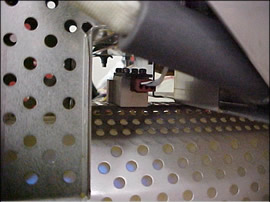Guide to UV Measurement
"On-Line" Monitors
On-line monitoring of the production process allows users to measure the radiant energy from the lamp and/or the reflector, noting any change that may occur. The sensors are most often mounted in a fixed location in the system.
On-Line monitors and sensors can be used to:
- Compare the performance of a system over time
- Detect changes that indicate when maintenance needs to be performed
- Detect changes that indicate when it is time to time to change a bulb
- Sound an alarm or stop production when the UV drops below a level that you have benchmarked
- Monitor UV on applications where it is hard to use a radiometer or other device-webs, fiber optics
- Monitor UV during production on an application with a very narrow process window
- Document the UV level for a particular job throughout the run of a job. The signal from the sensor can be fed into a computer or chart recorder. The results can be supplied with the product or stored as part of the quality record. For customers that require documentation, it answers the “how did you know the UV was strong enough for the entire run on my product?” question.
- Indicate, especially, in multiple lamp systems whether or not a UV system is performing as required or expected. Wide web systems sometimes use multiple 10“ (25 cm) microwave modules that extend the cure width to whatever is needed for the product. Individual lamp modules can become “buried” in the row. Sensors on each module can confirm that it is performing as expected. In multiple lamp systems like a wood line, on-line sensors could be used to indicate if UV systems in the middle of a three or four lamp bank are operating as expected.
- In some operations, the UV systems are isolated in a clean room and not visible to the operator working at floor level. Sensors can help determine if the systems are on and performing as expected.
- Provide feedback, which will allow a power supply to “close-the-loop” and adjust for changes in the UV output. On-line monitors have been used with power supplies that have the ability to input data. This allows the system to reduce fluctuations in the UV by having the power supply increase its output when the bulb ages or conditions change. On-line monitors have also been used in processes with light guides to confirm constant output from the light guide.
On-line monitors can be simple sensors, multiple-wavelength detectors and even spectroradiometers. In most UV curing systems, the sensors cannot be located to duplicate UV arriving at the cure surface, and therefore measure irradiance indirectly or on a relative basis. Sensors that are installed in a UV system need to be durable and resistant to avoid changes (solarization) induced by constant exposure to the UV source. Mounting location is important and some systems may use a shutter to reduce these effects.
Each UV system usually requires an individual sensor. Multiple lamp systems usually require multiple sensors. Often times it is best to place a sensor in the part of the system that is first expected to change - the extreme end of an arc lamp for example that tends to blacken as it ages.
The values reported are a relative measurement. With a newly-installed or newly-refurbished lamp system, or after a thorough cleaning of the reflector and bulb, the monitor is usually given a relative “intensity” of 100% or specific output value (volts or amps). This is the baseline and subsequent measurements are compared to the initial reading. As the percentage or output value decreases, it alerts the operator that a change has occurred in the curing system, and can use this as an indicator to establish a set point to take corrective action.
The advantage of on-line monitoring is that it is simple and automatic. It is not necessary to include a large number of parameters – in fact; one or two is usually adequate. This type of monitoring is best used to detect serious changes in key exposure parameters, and to indicate the need for maintenance before the process is affected. Periodic correlation with a calibrated radiometer is recommended.
|
 Online Sensor Mounted |

Compact Sensor
If readings can also be made with an absolute reading radiometer you should be able to make comparisons between different production lines.
The readings from on-line monitors can also be coordinated with absolute reading radiometers.
